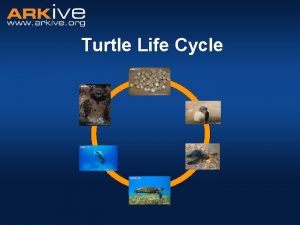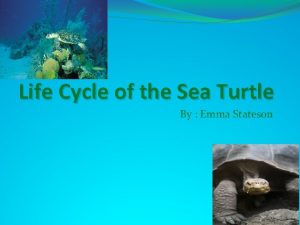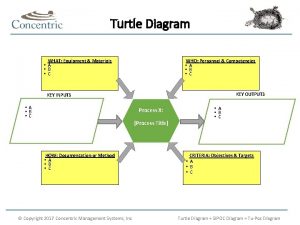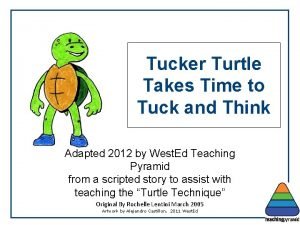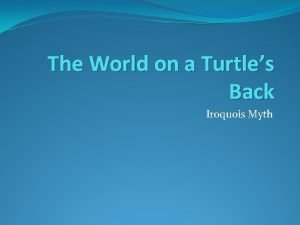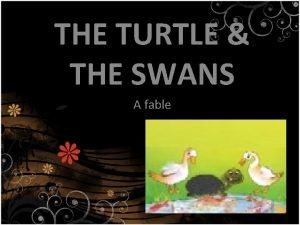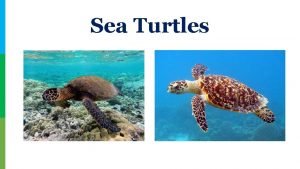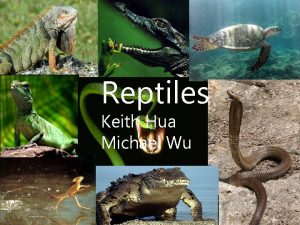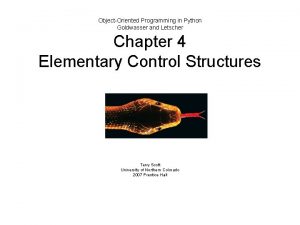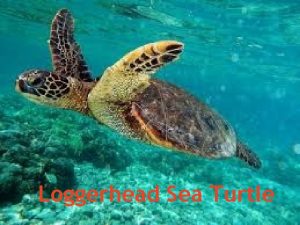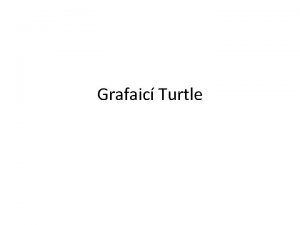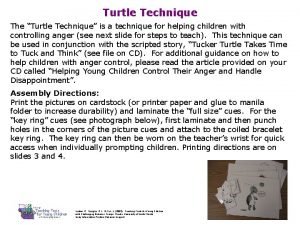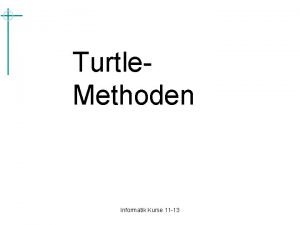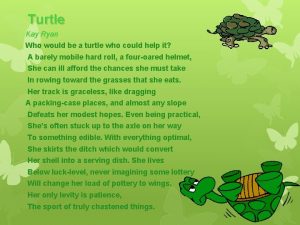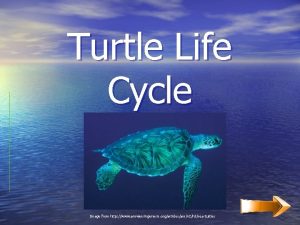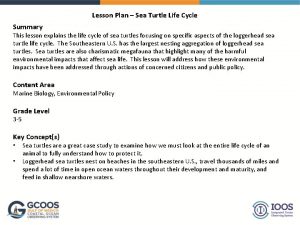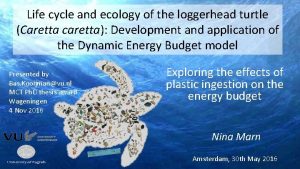Turtle Life Cycle What is a life cycle






























- Slides: 30

Turtle Life Cycle

What is a life cycle? • The different stages an animal or plant goes through during its life. • What stages might this include? - Birth or germination - Development - Reproduction

Species groups • There are many different species on the planet, and they belong to different groups. • Can you name some groups of species? INVERTEBRATES MAMMALS AMPHIBIANS PLANTS FISH FUNGI BIRDS REPTILES

Species groups • These are the groups we will be looking at today in more detail: MAMMALS AMPHIBIANS PLANTS REPTILES

Mammals Most mammals have very similar life cycles, with the individuals going through similar stages of development: • Female gives birth to young • Young looks like a miniature version of the adult • Female provides milk for the young to grow and develop • Adults take care of the young • Reproduce through sexual reproduction, involving sperm and eggs

Reptiles What do you think might be different about the life cycle of reptiles, when compared with the life cycle of mammals? What might be the same? • Most reptiles lay eggs • Young looks like a miniature version of the adult Generally, no parental care is given – the eggs/young are left to look after themselves • Most reptiles reproduce through internal sexual reproduction, involving sperm and eggs

Amphibians What do you know about the life cycle of amphibians? • Most amphibians lay eggs • After hatching, amphibians usually go through a very different physical form (tadpole) before looking like an adult • Tadpoles and young frogs are not usually given any parental care • Most amphibians reproduce through external sexual reproduction, involving sperm and eggs

Plants Plant life cycles are very different to the other life cycles we have looked at so far. But how? Let’s take a look at flowering plants… • Pollen is transferred from the stamen (male part) of one flower to the carpel (female part) of another flower – pollination • This pollen then joins with the ovules to become seeds – fertilisation • Seeds are then scattered – this can be through wind dispersal, or by animals • Seeds then grow into plants

Summary Eggs, live young Miniature or seeds version of adult Parental Care Live young Yes Reptiles Eggs Yes No Amphibians Eggs No No Seeds Yes No Mammals Flowering plants

Sea turtle life cycle • Which group do sea turtles belong to? • What does this tell us about their life cycle? Sexual reproduction No parental care Lay eggs Young are miniature versions of adults REPTILES

Sea turtles • There are seven different species of sea turtle Can you name any? Flatback turtle Hawksbill turtle Loggerhead turtle Olive ridley turtle Leatherback turtle Kemp’s ridley turtle

…and the GREEN TURTLE!

Green turtle Why are they called green turtles? Because their fat is green in colour! Female green turtles can lay between 100 and 150 eggs per clutch, and usually lay several clutches per breeding season. Some populations of green turtle migrate thousands of kilometres to feed and breed. Part of the Brazilian population migrates 2, 250 kilometres to breed near Ascension Island in the South Atlantic! Green turtles can live a very long time! Scientists are not sure exactly how long, but it is thought that it could be up to 100 years or more!

Green turtle life cycle

Starts off as an egg Green turtle life cycle

Green turtle life cycle Egg Stage • Eggs are incubated in the nest for 45 to 70 days • The temperature affects the sex of the young: - Lower temperatures produce males - Higher temperatures produce females - Middle temperatures produce males and females Threats • Eggs being taken by humans for food • Feral/wild pigs and domestic dogs digging up the nest • The nest getting flooded

Starts off as an egg Green turtle life cycle Hatchling emerges from egg Hatchling makes its way to the sea

Green turtle life cycle Hatchling stage • Hatchlings look like miniature adults • Hatchlings get no parental care • Hatchlings head towards the lighter horizon, which will be over the sea Threats • Predators – gulls and crabs on the beach, and fish and sharks once the hatchlings reach the sea • Artificial lighting – hatchlings head towards that instead of the sea

Starts off as an egg Green turtle life cycle Hatchling emerges from egg Hatchling makes its way to the sea Hatchling grows into a juvenile and then into an adult

Green turtle life cycle Juvenile stage Where do juveniles go? • Nobody really knows! Scientists have yet to figure out exactly where they go between the hatchling and juvenile stages – it’s a mystery! • End up in feeding areas – exact location not known Threats • Eating plastic bags – the turtles think the bags are jellyfish • Fishing nets and lines

Starts off as an egg Green turtle life cycle When the turtles reach sexual maturity they mate and reproduce Hatchling emerges from egg Hatchling makes its way to the sea Hatchling grows into a juvenile and then into an adult

Green turtle life cycle Adult stage • Reach sexual maturity between 26 and 40 years old • Migrate from feeding grounds to breeding grounds • Breeding ground is the beach where they hatched • Males and females mate just offshore • Males return to feeding grounds Threats • Getting caught in fishing lines and drowning • Sharks

Starts off as an egg Female turtles crawl onto the beach to lay their own eggs When the turtles reach sexual maturity they mate and reproduce Green turtle life cycle Hatchling emerges from egg Hatchling travels to the sea Hatchling grows into a juvenile and then into an adult

Green turtle life cycle Egg laying • Female crawls onto the beach at night to lay eggs • Female uses its back flippers to dig a nest • Lays eggs in nest • Female may come up onto the beach up to nine times per nesting season to lay eggs • Once several clutches of eggs have been laid, female returns to feeding grounds Threats • Beach pollution • Noise and lights

Starts off as an egg Female turtles crawl onto the beach to lay their own eggs When the turtles reach sexual maturity they mate and reproduce Green turtle life cycle Hatchling emerges from egg Hatchling travels to the sea Hatchling grows into a juvenile and then into an adult

Helping the turtles! It is not all doom and gloom! What is being done to help green turtles complete their life cycle? • Hatcheries • Beach patrols A green turtle hatchery • Turtle Excluder Devices (known as ‘TEDs’) TEDs are special ‘trap doors’ in fishing nets that enable turtles and other large marine animals such as sharks to escape safely. Target fish and shrimps go through a grid at the neck of the main net and into a catch net on the other side, but larger animals such as turtles can’t fit through the barriers, and so escape by swimming out through a special opening in the main net.

Helping the turtles! What can you do? - Try to reduce the amount of plastic products you use (e. g. water bottles and plastic bags) - Try to reuse any plastic items you have - Recycle your rubbish where possible REDUCE…REUSE…RECYCLE!!

Summary Start off as eggs Hatchlings hatch and head into the sea Do not really know where juveniles go – lost years! Migrate to feeding grounds Reach sexual maturity Migrate back to the area where they hatched, and mate offshore Males return to feeding grounds Females go onto beach to lay their own eggs Turtles face a lot of threats during their life cycle, which is why only 1 in 1, 000 survive to adulthood!!!

Activity • Turtle Life Cycle Game • You are going to complete a turtle’s life cycle! • Starting as an egg, you have to journey through the different stages of a turtle’s life cycle, finishing when you lay your own eggs • Along the way you will encounter some of the real threats that green turtles face, and see how hard it is for a turtle to survive to produce its own young! • Split into groups of four, collect one board game set per group, and begin… GOOD LUCK!!

Recap… Stage Threats Egg • Humans • Dogs and Pigs • Flooding Hatchling • Artificial light • Predators Juvenile • Plastic bags • Fishing lines Adult • Fishing lines • Hunting/poaching Mating Female – lays eggs Male – returns to feeding grounds • Polluted beaches • Hunting/poaching • Noise and light
 Turtle life cycle stages
Turtle life cycle stages Life cycle of a hawksbill sea turtle
Life cycle of a hawksbill sea turtle Run marco brainpop
Run marco brainpop Schier grease trap gb-75
Schier grease trap gb-75 Turtle
Turtle Rectangle
Rectangle Sea turtle diagram
Sea turtle diagram Tucker turtle takes time to tuck and think
Tucker turtle takes time to tuck and think Iroquois
Iroquois The turtle and the swans question answer
The turtle and the swans question answer Turtle digestive system
Turtle digestive system Graphic practice
Graphic practice Hawksbill sea turtle size
Hawksbill sea turtle size Circulation in reptiles
Circulation in reptiles Python turtle
Python turtle Emotional competence
Emotional competence Python lesson 1
Python lesson 1 Python turtle
Python turtle Small basic turtle
Small basic turtle Small basic turtle triangle code
Small basic turtle triangle code Turtle graphics logo
Turtle graphics logo Ll logo
Ll logo Loggerhead turtle range
Loggerhead turtle range Leatherback sea turtle biome
Leatherback sea turtle biome Owl fox teddy bear shark turtle
Owl fox teddy bear shark turtle Turtle shark teddy bear fox owl test
Turtle shark teddy bear fox owl test Owl conflict style
Owl conflict style Turtle bayou resolutions
Turtle bayou resolutions Mexico map 1821
Mexico map 1821 From turtle import *
From turtle import * Chuck baird art no 2
Chuck baird art no 2
